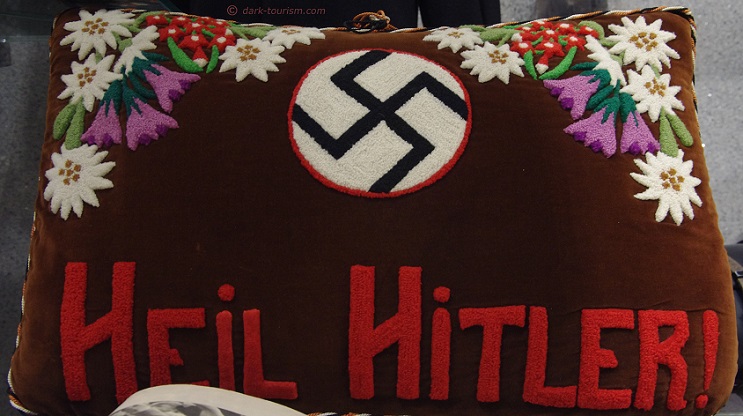Another one related to my recent purge from Facebook. I mentioned in my earlier post about this censorship case that I had posted photos on Facebook that I would have considered more “risqué” than the one that started all the trouble. Here’s an example from way back, namely from 25 May 2017.
This had been part of a themed week of posts all showing the “fluffy side of something” (see below!). This was probably the photo for which I would have understood it most had it triggered some algorithm alarm. But it didn’t. At least not at the time.
However, what I could imagine happened is that after the initial detection of an “offence”, namely with that post from 20 April 2020, some algorithm may have been set in motion that then trawled back through my entire page’s five years of posts picking up other “offensive” ones. Indeed after that initial post, for which I received an email threatening “only” a 30-day ban, I later received a whole string of further emails complaining about posts going “against community standards” … only at that point I was already locked out of my personal account so I could not see which posts these may have been, because the links in those emails prompting me to “see it on Facebook” only took me to the log-in page, where I could no longer log in. But I can well imagine that this fluffy Nazi cushion would have been one of them, if what happened was indeed a string of algorithms spinning out of control. However, it was embedded in a themed context, and it shows another museum display, and the text it came with made it quite clear that this was not promoting Nazism, quite the opposite (but of course the dumb algorithms can’t understand such complexities).
This was the text that this post originally came with on 25 May 2017:
“Photo of the Day: the fluffy theme continued even further. And if you thought it couldn’t possibly get as far as “The fluffy side of Nazism”, think again, because here it comes!
This embroidered cushion is an exhibit at the “Heeresgeschichtliches Museum (HGM)” at the Arsenal in Vienna, Austria. This military history museum is actually the oldest of all those grand museums in this city. Before World War One its purpose was primarily to glorify the Habsburg Empire’s military tradition and might.
This has since changed considerably, of course. In fact even in recent years the museum has undergone further modernization, esp. with a brand-new, state-of-the-art section about WW1, opened on the centenary of the outbreak of the Great War (and in my view this new exhibition even beats its equivalent at the Imperial War Museum in London in quality!).
But this particular artefact is to be found in the section about the Third Reich and WWII, of course. It’s not even the only item of such “dodginess”, they also have a jolly lantern with the Nazi symbol on it and also a golden Adolf bust (protected by perspex).
But don’t let that give you the wrong idea. The museum is as far from celebrating this dark era as you can get. In fact, having such shockingly “distasteful” items (from today’s perspective) on display is actually rather courageous, I think, from a point of view of museum curatorship. It certainly confronts you with a very poignant impression of how comfortably (even literally!) ultra-right-wing symbolism can go with homely cosiness. In that sense I find an exhibit like this far more chilling and disturbing than displays of weapons or uniforms or images of Hitler in mid-agitation. This unexpected Nazi-cushion is certainly one of the must unusual and thus most memorable artefact I’ve ever seen in any museum exhibition on this subject.
Finally I don’t want to finish this post without mentioning the cool slogan that this museum has adopted: “Kriege gehören ins Museum” – ‘war belongs in a museum’ (i.e. rather than in the real, contemporary world)!”
Anyone who can read and understand English should be able to see that this does not constitute anything objectionable. Even where the public display of Nazi symbols is outlawed, museums are usually exempt. Indeed they have to cover these topics. But if you then can’t talk about this, then what’s the point?
You may now wonder what the other fluffy items in this series may have been. So here we go, I’ll reproduce those too:
On Monday, 22 May 2017, I kicked off with this photo:
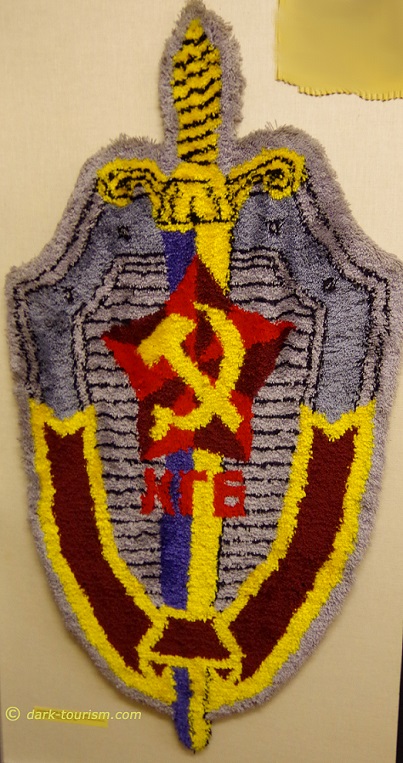
And the accompanying text was this:
“Photo of the Day: to compensate for last week’s spiky barbed-wire theme, this week I’ll go all soft and fluffy – while still maintaining dark associations, of course …
So let’s begin this week with a look at the fluffy side of the KGB, the former Soviet Union‘s infamous secret service and intelligence agency.
Of course, this is just about the only side of the KGB that can be called fluffy. In all other regards it’s a name that still triggers reflex reactions of fear and loathing … as well as some curiosity about this organization’s mysterious secrecy.
KGB, btw., stands for “Komitet Gosudarstvennoy Bezopasnosti” (‘Committee for State Security’). Internally its purpose was to keep the Soviet population under surveillance and stamp out any subversion or opposition to the communist regime. Internationally, it was the USSR’s spy network, the direct counterpart to the USA’s CIA or the UK’s MI6. Brings back images of old James Bond movies, doesn’t it?
In the real world, the KGB broke up together with the USSR in 1991, but its successor organizations still exist in Russia, most notably the FSB (for “Federal’naya sluzhba bezopasnosti” – ‘federal security service’).
However, outside Russia the KGB still carries on: namely in Belarus and also in Transnistria! (Both just never bothered to change the name for their secret service.) That is also quite fitting in a way, in as much as both these places maintain a lot of “Sovietness” in general. The latter has even been called “a Soviet open-air museum”. But that’s for another post some other time …”
The next day, on Tuesday 23 May 2017, I followed this up with this photo:
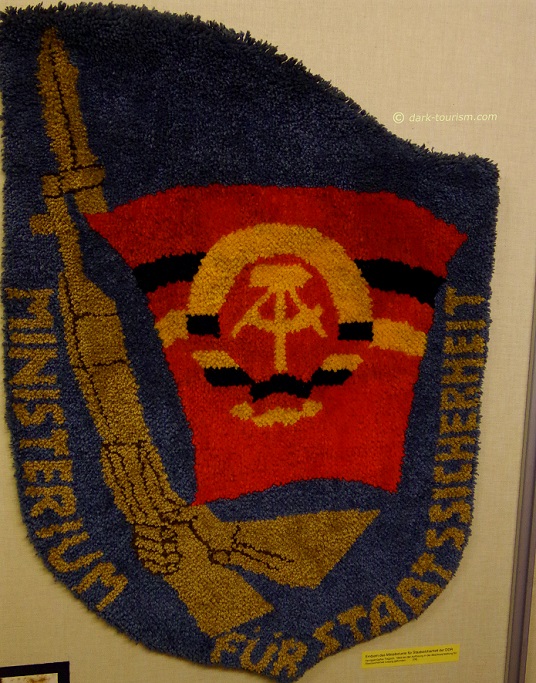
And that came with this accompanying text:
“Photo of the Day: follow-up to yesterday’s post … and here comes the fluffy side of the Stasi!
The Stasi was the equivalent of the KGB in the GDR, the “German Democratic Republic’, or simply ‘East Germany’, during the Cold War era, when the GDR was a “Bruderstaat” (‘brother state’) of the USSR and part of the Warsaw Pact/Eastern Bloc. In fact the Stasi and the KGB worked closely together.
The Stasi was actually the largest state security police organization in history, if measured in relation to the size of the population it kept under surveillance (ca. 16 million). It officially employed over 90,000 people and in addition recruited roughly twice as many so-called “IMs”, which stands for “inoffizielle Mitarbeiter” – ‘unofficial collaborators’. These were often coerced or threatened (or lured by perks and career advantages) into spying and writing reports on their colleagues, neighbours, friends and in many cases even their own family members.
Stasi, btw., is short for “Ministerium für Staatssicherheit” (‘Ministry of State Security”, or simply “Staatssicherheit”) and internally had the additional epithet “Schild und Schwert der Partei” (‘shield and sword of the party’).
When I saw this fluffy Stasi emblem on the wall in one of the memorial sites in Germany I immediately thought: wouldn’t it be cool to have one of these to put in front of my loo at home? … is that a legitimate thought? Or would that be too disrespectful? But then again, wouldn’t it be disrespect directed at quite a deserving target? Or still in too iconoclastic a way? Not so easy, is it? Anyway, it was only a thought experiment, since I doubt that specimens of this fluffy symbol would be available anywhere other than as exhibits in museums … or am I wrong?”
On Wednesday 24 May 2017, the next instalment of the series was this photo:
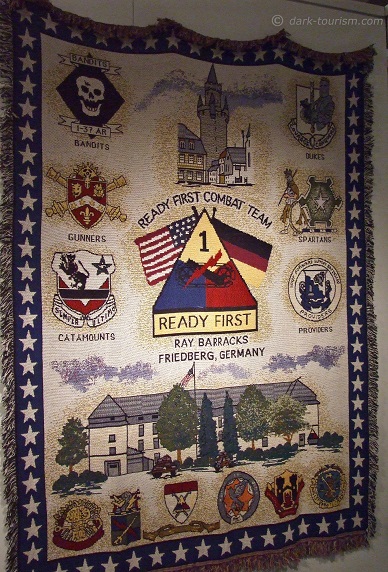
… and that came with this text:
“Photo of the Day: continuing the fluffy theme of this week – but now looking across the former Iron Curtain, at the Western side: here’s the fluffy side of the American military presence in Germany – and a bit of Elvis (see below)!
All through the Cold-War era the USA maintained a strong military presence (including plenty of nuclear weapons!) in West Germany (‘FRG‘), its former-WWII-enemy-turned-key-ally in NATO. And to a lesser degree it has continued its military presence ever since Germany’s reunification and the end of the Cold War as well.
The American military bases were/are mostly located in the south-west of Germany, and include the (in)famous Ramstein. It still serves as the HQ for the US Air Force in Europe. In 1988 it was the site of a tragic air show disaster in which 70 people were killed – and which in turn gave rise to the band name “Rammstein” (slightly misspelled, but at the same time alluding to the word “rammen”, ‘to ram’).
The Ray Barracks in Friedberg, celebrated in this wall rug spotted at the Allied Museum in Berlin, was, however, closed in 2007 and the forces stationed there were sent home to the US.
But to come back to the Elvis reference in the first paragraph: one famous soldier to have served at Ray Barracks long before that, back in 1958, was indeed Elvis Presley!
The then entertainment superstar had to suspend his career for two years when he was drafted. He declined the offer of doing only “Special Services” (aka “celebrity wimp-out” amongst ordinary soldiers), meaning he would have done merely basic military training for a few weeks and then just toured army bases but otherwise more or less continued his stardom lifestyle. But instead he served, nominally, as a regular soldier and was stationed at Ray Barracks, Germany.
The decision wasn’t quite as heroic as it was/is widely seen, though. In fact it was a deliberate decision by his manager that it would be better at this point in Elvis’ career for him to step out of the limelight for those two years (at a point when more conservative, older Americans viewed him as a menace to society), pocket the respect that doing regular military service would earn him, as it did, and then return to continue his career as an even bigger star.
His military service in Germany also wasn’t quite so “ordinary” after all. He was quickly allowed to live “off post” and he took up base first in hotels, then in a house he purchased. So no regular barracks life for him.
It was also during his military duty in Germany that he picked up his amphetamine habit, which would lead to his addiction to various drugs that eventually played a major part in his untimely death, at age 42, in 1977.”
On Thursday 25 May 2017 this was followed by that Nazi-cushion post that we began with (see above), and on Friday 26 May 2017 the series finished with this photo:
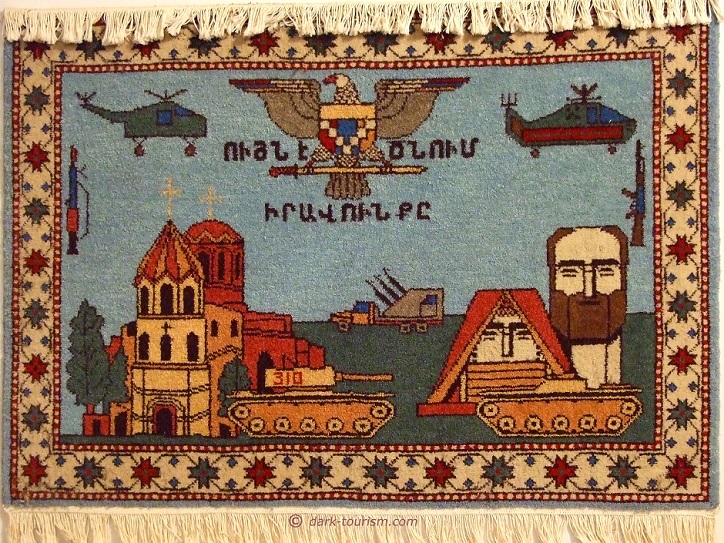
And this final fluffy-side-of-X post came with the following text:
“Photo of the Day: … and to finish this week’s theme: here’s the fluffy side of the Nagorno-Karabakh war!
And again, in reality there’s nothing fluffy about it. This is one of the world’s “frozen conflicts” to which there just doesn’t seem to be a genuinely possible solution. It’s like the Middle East (esp. Israel and Palestine), but in the Caucasus.
In this case the bone of contention at the heart of this insurmountable enmity is a disputed territory that is “de jure” (officially, by international law) still part of Azerbaijan but is “de facto” part of Armenia – or rather: it’s a quasi-exclave of Armenia, geographically separate but with an ethnically mostly Armenian population, and cultural and religious roots that are also firmly Armenian. And it’s been militarily protected by Armenian forces (with a little help from Russia) for almost two and a half decades. The actual full-scale war in Karabakh, which ended in this stalemate, lasted from 1991 to 1994.
The territory nominally declared itself an independent state in 1991 – but this independence has not been officially recognized by any of the UN countries. The only entities that do recognize it are similarly contested self-declared but (mostly) unrecognized break-away republics – namely Transnistria (formerly part of Moldova), as well as Abkhazia and South Ossetia (both formerly part of Georgia, also in the Caucasus).”
So this has become a rather long blog entry, incorporating a partial resurrection of a set of posts originally on my purged Facebook page. I may dig into my archive for more such resurrections, although you will eventually also find them in the Archive pages on dark-tourism.com, when they’re finished, but there you have to do a lot of scrolling, and there are no current adaptations like there are here. But I’ll also start posting completely new items on this blog page.

